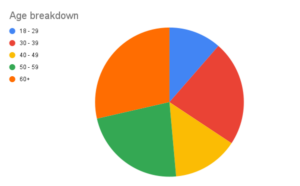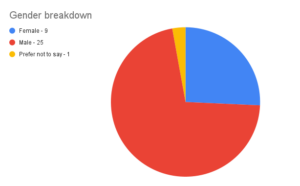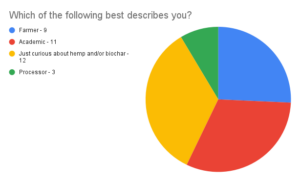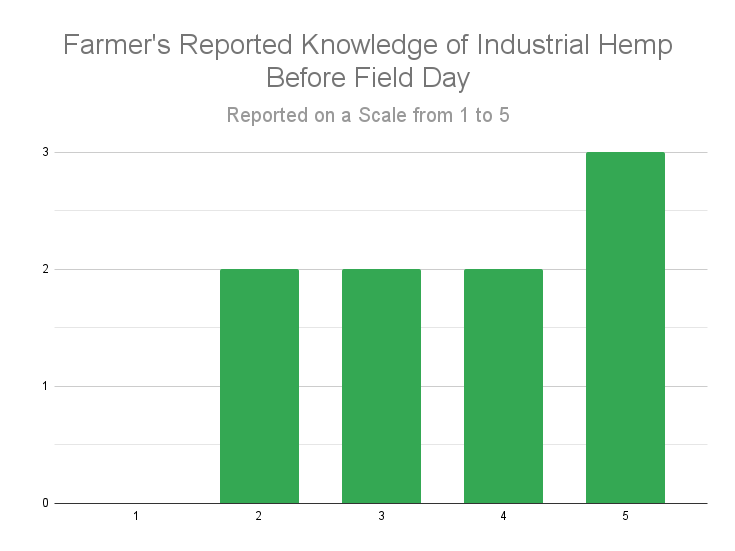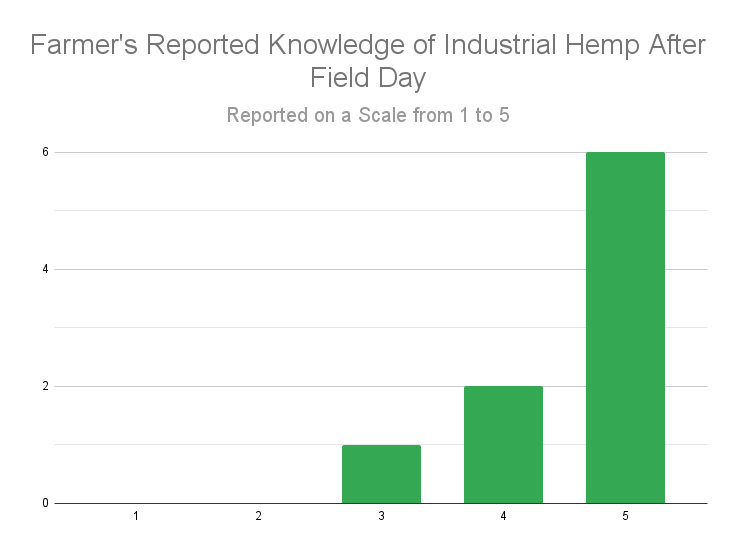Progress report for FW21-377
Project Information
Biochar is a high-value soil amendment that is sustainably made from agricultural and forest management byproducts. When properly charged with nutrients and beneficial soil microbes, biochar has been demonstrated to improve both crop yield and yield quality while also increasing soil nutrient cycling capacity, soil water holding capacity and soil organic matter. Increasing soil organic matter is critical to sequestering carbon dioxide to reduce atmospheric greenhouse gasses and mitigate the effects of climate change. Crop yield quality and mass is critical in the cultivation of Industrial Hemp (Cannabis sativa L.) for fiber. We have also begun to observe the effect of these soil treatments on cover crops grown in the crop rotation.
We are observing the effects of a biochar, compost, a biochar-compost blend, and a control treatment on a no-till hemp cropping system that grows a crop of hemp and a cool season cover crop in a calendar year. After pandemic-related delays and shifting life circumstances the project has entered its first year. We have begun to observe the immediate impacts of biochar and compost on soil quality and soon our first cover crop. Our hypothesis remains that biochar presents a net benefit on yield and soil quality. Furthermore, we are assessing if there is a plateau in soil benefits and/or diminishing marginal returns in yield increases.
Test the effects of biochar, compost and a biochar-compost blend on soil quality, cover crop yields, industrial hemp yields and plant quality (as measured by leaf tissue analysis) in a no-till production system.
Note: all gantt chart files are large, it may take a few seconds for the resolution to update when zooming in.
Combined Project timeline
2021 Timeline
2022 Timeline
2023 Timeline
Cooperators
- (Educator)
- - Producer
- - Technical Advisor
- (Researcher)
Research
Introduction
This experiment observes the effects of different treatments of a biochar-compost blend on soil quality, soil nutrient levels and industrial hemp and cover crop production over two years in a certified organic farming system. This experiment is being conducted in Lemoore, CA located in California's San Joaquin Valley.
This experiment is observing the effects of different treatments of biochar, compost, and a biochar-compost blend on soil quality, soil nutrient levels and industrial hemp and cover crop production over the course of two years in a certified organic no-till cropping system. The crops cultivated in this system rotate between a spring-planted Short-Day fiber Hemp and a Fall-Planted Cover Crop blend.
Objective
Test the effects of biochar, compost and a biochar-compost blend on soil quality, cover crop yields, industrial hemp yields and plant quality (as measured by leaf tissue analysis) in a no-till production system.
Materials
The biochar used for this trial was sourced from Biochar Now, LLC ("Biochar Now") and Corigin Solutions, LLC ("Corigin"). The compost used for this trial is procured from Kochergen Farms Composting based in Kettleman City, CA
Methods
Our original plan for the experiment was to have four treatments with three replications on twelve 25’x225’ ⅛-acre strip plots. After we had defined the twelve test plots, we had an opportunity to add a second type of biochar, from Corigin. Because Corigin and Biochar Now use two very different methods to create biochar, we decided to add it to our experiment. After this planning, we had six treatments:
- No Treatment (control)
- 10 tons of compost per acre equivalent
- 1 ton of Corigin biochar per acre equivalent
- 1 ton of Corigin biochar blended with 9 tons of compost per acre equivalent
- 1 ton of Biochar Now biochar per acre equivalent
- 1 ton of Biochar Now biochar blended with 9 tons of compost per acre equivalent
Due to the late addition of the second biochar type to the experiment, we had to split some of the biochar and biochar + compost plots into 12’ wide plots to accommodate the new biochar types. Our original plan was to have three replications. However some of our biochar got mixed at the wrong rates so we had to eliminate some of our reps. Ultimately, we ended up with the following plots 15 strip plots (A and B indicate plots that were subdivided from 25’ to 12’ wide strips):
- Compost - amend with compost (done)
- Biochar - split into two plots:
- (A) Corigin Biochar
- (B) Biochar Now - amend with half a super sack of Biochar Now biochar (done)
- Control
- Biochar Now
- Biochar /Compost Blend
- (A) Corigin/Compost Blend
- (B) Biochar Now/Compost Blend
- Control
- Biochar/Compost Blend -
- (A) Corigin/Compost Blend
- (B) Biochar Now/Compost Blend
- Biochar Now
- Compost
- Control
- Biochar/Compost Blend - split into two plots
- (A) Corigin/compost blend
- (B) Biochar now/compost blend
Each year, three crops will be grown on the treatment blocks:
- Cool-Season Cover Crop
- Planting window: November
- SoilMax Organic Legume Blend from L.A. Hearne Seed Co
- 15% Oats, 25% Peas, 30% Vetch, 30% Broad Beans
- Planting Rate: 150lb per acre
- Drill seeds
- Germinate cover crop with sprinklers
- Mow cover crop if necessary to prevent maturation
- Terminate cover crop via crop roller in February
- Spring:
- Direct Seed into cover crop stubble
- Planting window: March-April
- Direct seed via seed drill
- Germinate with sprinklers
- Irrigate with drip
- Harvest with weather before flower initiation in September
Milestones
The two crops grown on the treatment blocks are as follows:
Cool-Season Cover Crop - Year 1
- Planting date: February 19, 2022
- Cover Crop Blend:
- 15% Oats
- 25% Peas
- 30% Vetch
- 30% Broad Beans
- Planting Rate:
- Seed drill
- Germinate seed cover crop with rain and/or impact sprinkler
- Terminate cover crop via flail mower
Spring Hemp - Year 1
- Planting date: mid-April 2022
- Feminized Hemp Seed
- Plant Spacing
- 12” x 15” on beds
- 3 rows per bed
- 108 plants per bed
- 1,512 plants per treatment
- 4,536 plants per cycle
- Equivalent to 34,848 plants per acre
- Direct seed via push-cart seeder
- Germinate with impact sprinkler
- Irrigate with drip
- Fertigate with compost tea
Objective 1: Observe treatment effects on soil quality
Ward Laboratories, Inc. (“Ward Labs”) and students from Los Angeles Pierce College Horticulture Department (“Pierce College”) have provided comprehensive soil testing. These tests include the following data points:
- primary nutrients (N, P, K)
- secondary exchangeable and soluble nutrients (Ca, Mg, Na, SAR)
- micronutrients (Zn, Mn, Fe, Cu)
- cation exchange capacity (CEC)
- Base Saturation
- Soil salinity
- pH
- Soil Organic Matter.
The soil data collected by Pierce College students tested the soil pre-treatment and the Ward Labs data tested post-treatment. Eventually, the Pierce College student data will include post-treatment; however, this data is not expected to be made available until late April/early May of this year. The plan is for soil tests to continue prior to the application of the biochar/compost blend treatments and after each crop; in order to measure the effects caused by the treatment and any interactions between the treatment and the subsequent sequence of hemp and cover crops cultivated on the plot.
Objective 2: Observe treatment effects on industrial hemp and cover crop yields
Data collection and observations on crop productivity are conducted throughout each cropping cycle.
Objective 2: Observe treatment effects on industrial hemp and cover crop yields
Data collection and observations on crop productivity and yields will be conducted throughout each cropping cycle.
- Timelapse Photography - A camera will be set up with a profile view of the field with yardstick markers for reference. Camera will be set to automatically take 5 photos a day.
- Leaf Tissue Analyses - Our original plan was to conduct three leaf tissue analyses per crop on four treatments. However, we decided to reduce this down to two leaf tissue analyses per crop because we went up to six treatments. This allowed us to conduct the same number of tests and still fit the budget.
- Two leaf tissue tests will be conducted per cropping cycle for each treatment
- First leaf tissue analysis will be conducted during the third week of plant growth
- Third leaf tissue analysis will be conducted the week before harvest or cover crop termination
- 2 leaf tissue analyses per treatment, 12 leaf tissue analyses per cropping cycle
- 48 Leaf Tissue Analyses for the entire project (4 crops)
- Two leaf tissue tests will be conducted per cropping cycle for each treatment
- Total plant weight estimate (cover crops)
- Use the “clip and weigh” sampling method to estimate total cover crop weight
- Yield tabulation (hemp)
- Plants will be mechanically harvested with combines
- Total straw yield shall be weighed and measured
Research Outcomes
Education and Outreach
Participation Summary:
Hemp Feld Day
Field Day Promo
On June 28, 2021 Tony de Veyra released a promotional video for a field day to be held at the project site in Lemoore, CA the following month.
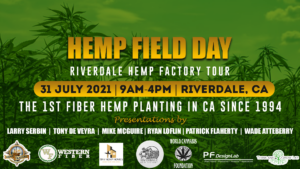
On July 31, 2021, Tony de Veyra organized a hemp field day on the farm in Lemoore, CA to showcase the first ever hemp fiber crop in California since 1994. With over one hundred attendees the field day was a success attracting farmers, industrial hemp processors, academics, and those just curious about industrial hemp. The day's educational programming included biochar as a soil amendment where Tony spoke about its benefit to soil health and plant vigor.
Attendees were asked to take a brief survey that sought to measure the impacts of the day's educational content. Of the roughly one hundred attendees, thirty-five completed the survey.

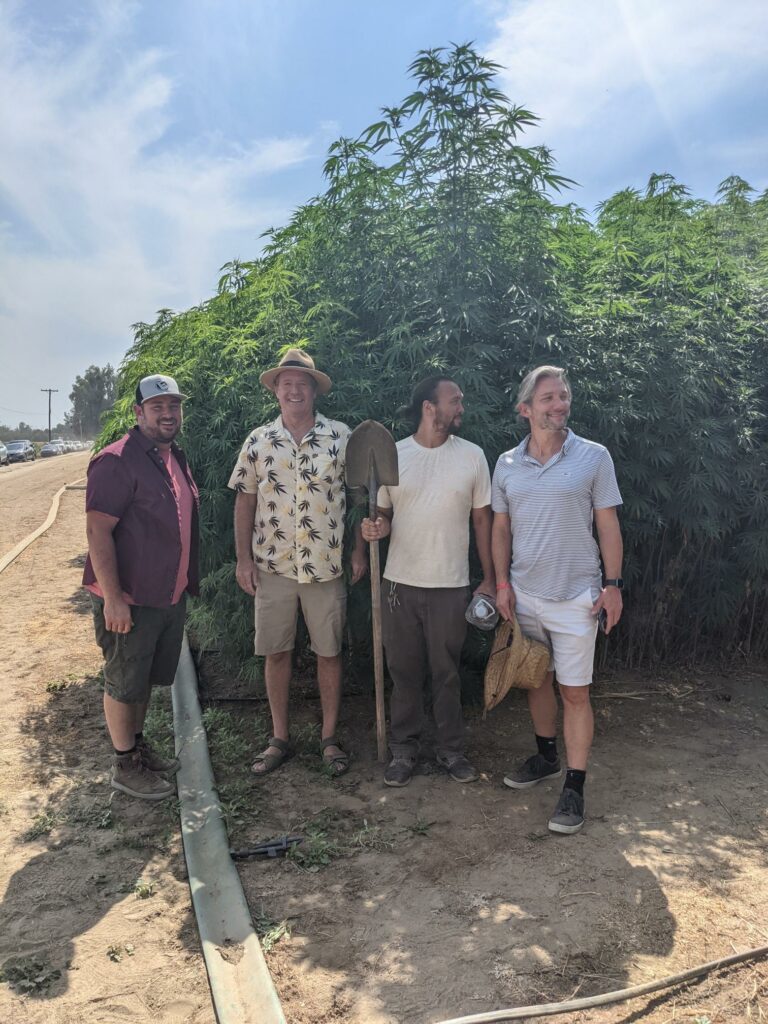
Hemp Field Day Survey Results - Respondent Profile
Summarized in these three charts the sample demographic was overwhelmingly male and skewed older. In this group, nine self-identified as farmers. Furthermore, taking into consideration farmers plus those who responded as processors and academics twenty three respondents total were considered ag professionals. Ag professionals are defined as a combination of respondents who self-identified as a farmer, academic, or processor.
Survey Results
The survey instrument asked attendees to rate their knowledge of the two key project elements, industrial hemp and biochar, on a scale from one to five. One being the lowest “low knowledge” and five being the highest “high knowledge”.
Of the nine self-identified farmers in the survey, reported knowledge of industrial hemp before the field day was nearly uniform with a slight bias left towards high knowledge. After the field day this bias becomes more expressed. Six out of nine farmers rate themselves at “high knowledge” and the lowest self-reported knowledge becomes a rating of three
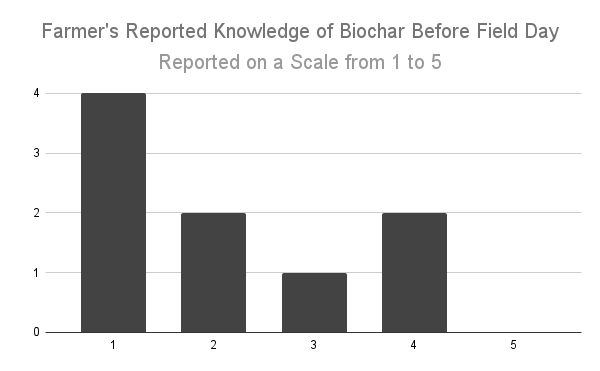
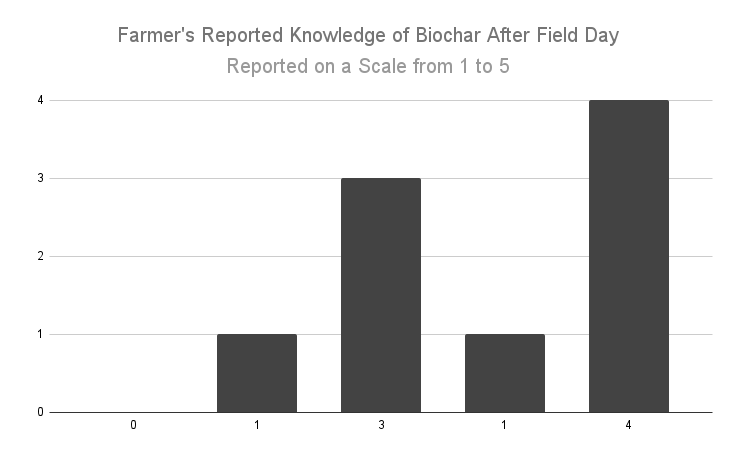 Self-reported biochar knowledge, on the other hand, skewed right and exhibited more variance before the field day programming. After, the skew reversed and self-reported farmer knowledge increased.
Self-reported biochar knowledge, on the other hand, skewed right and exhibited more variance before the field day programming. After, the skew reversed and self-reported farmer knowledge increased.
Discussion
With such a small subset of survey respondents identifying as farmers we cannot test for statistical significance or run a deeper analysis. However, we are able to conjecture about the changes before and after for each subject. For industrial hemp, having no respondents rate themselves as “low knowledge” isn’t surprising. The focus of the field day was industrial hemp and it’s reasonable to assume self-identified farmers in attendance had at least some industrial hemp knowledge. Then coming out of the day’s programming a greater share of farmers reporting high knowledge provides some indication there was educational value to the day.
When it came to initially low knowledge ratings relative to biochar this was surprising. This is given the body of research uncovered during our initial literature review documenting biochar’s positive effects on crop yields; moreover, biochar is crop agnostic and applicable to many different feedstocks. Yet, recently reviewed articles suggest mixed results from biochar studies and even potentially harmful effects.
Another explanation could be the lack of research of biochar’s direct effects on industrial hemp. Under the assumption respondents self-selected themselves into the sample because this was a hemp-themed field day; their exposure to outside knowledge related to biochar’s purported benefits to hemp as a feedstock would be less than their peers.
Biochar Field Day
On September 16, 2021 we held another field day at the hemp processing facility in Riverdale. This field day had two main topics: the uses of biochar and the prospects of industrial hemp. We had 50 attendees, primarily growers and dairymen. One of our biochar suppliers, Biochar Now, was present to give a presentation and talk about the uses of biochar and the different ways to make biochar. Principal Investigator Tony de Veyra also gave a short talk about the upcoming biochar experiment funded by Western SARE. We had tours of the field and of the processing facility.
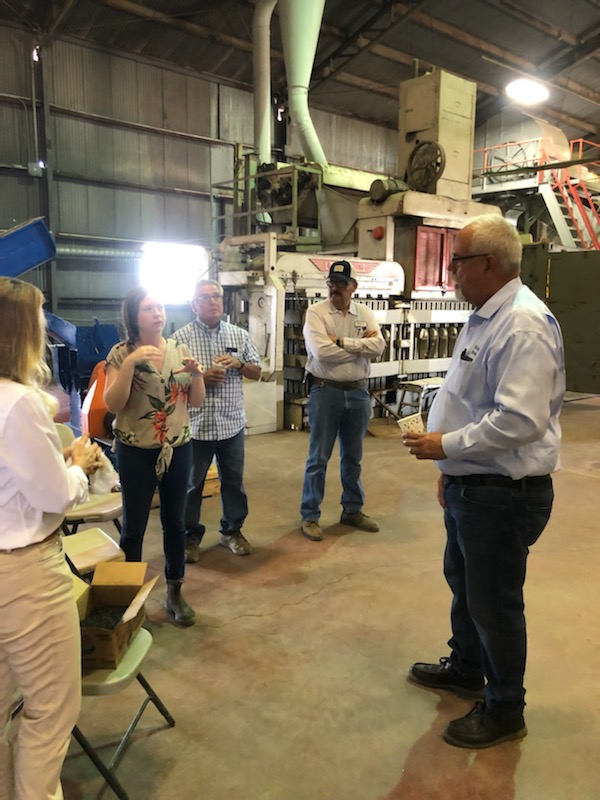
Education and Outreach Outcomes
Project Methodology
At this point in the project due to delays we’ve just begun to implement the project. We need to collect more data to modify our methodology. However, we will continue to observe the project closely and adjust our approach as needed. No till
However, recently discovered research runs contrary to our team’s understanding of biochar’s effects on soil health (Gale et al., 2016) . This element of doubt did not exist during our initial literature review which indicated overwhelming benefits to soil and plants. As the project continues to generate data we may test for the presence of heavy metals during soil testing should the budget allow. This is important because as this new strain of biochar literature exists this research has the potential to corroborate those findings.
Even further, as suggests, the conditions under which biochar is produced may be the key to avoiding detrimental effects to soil health (Yaashikaa et al., 2020). Should any negative effects be observed we’ll need to scrutinize the process of our biochar supplier.
Research Design and Data Collection
Future data collection via planned surveys are going to hone in on respondent knowledge of industrial hemp and biochar. For example, the quality of sources respondents are obtaining their knowledge from. Is it by word of mouth or from online sources? Our initial pre-post assessment of educational programming can be improved by exploring these nuances. This is key to painting a clearer picture of our target demographic’s prior knowledge of industrial hemp and biochar.
